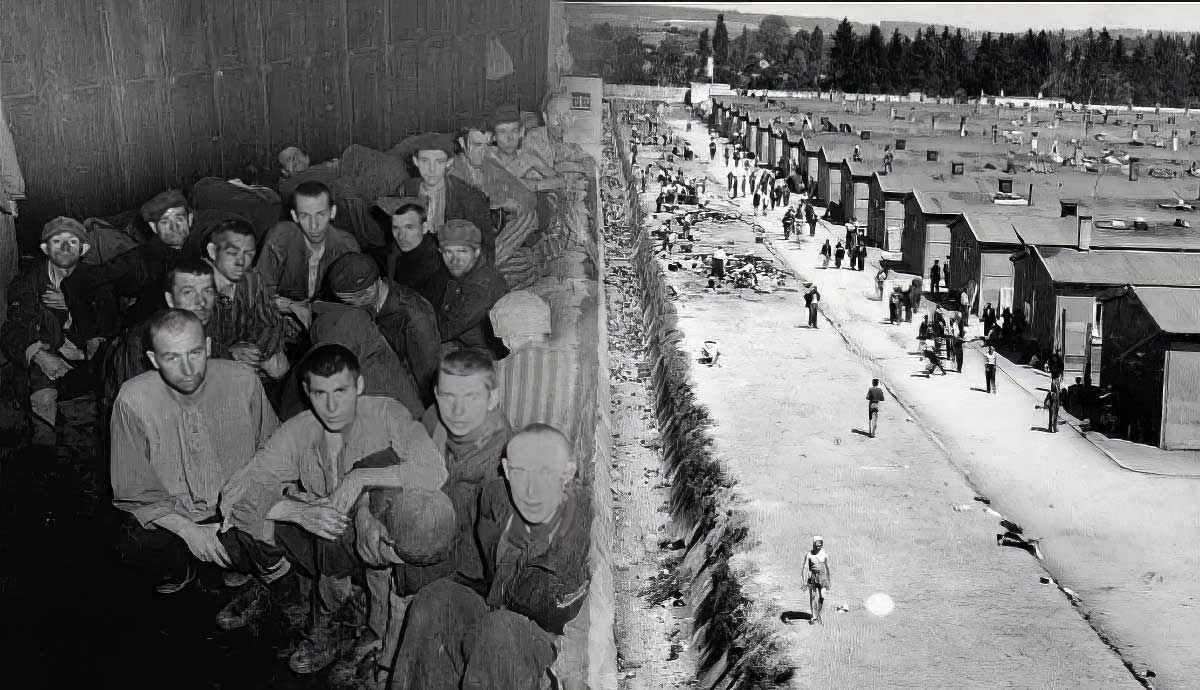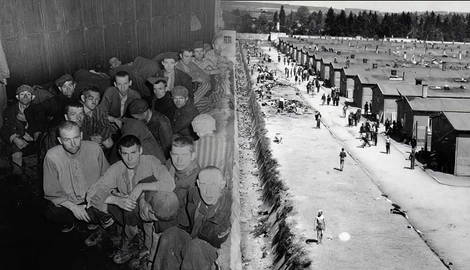
Shortly after Adolf Hitler assumed power as Chancellor of Germany, a political and criminal prisoner camp was established in the town of Dachau in the spring of 1933. Unlike other camps that were used for mass murder, Dachau was initially created to house prisoners that were deemed a threat to the Nazi regime. Upon the Nazi invasion of Poland in 1939, the purpose of Dachau began to change. As American, British, and Soviet forces pushed into Germany and surrounding occupied areas near the end of World War II, they discovered the atrocities of thousands of concentration camps and hundreds of thousands of starved, diseased, and dead prisoners.
Before the Liberation of Dachau

Reich Leader of the Nazi Protection Squadrons, known as the Schutzstaffel (SS), and Chief of the Munich Police Heinrich Himmler was appointed by Adolf Hitler as his second-in-command. On March 20, 1933, Himmler announced that the first concentration camp in Nazi Germany would open to house political and criminal prisoners of war that threatened the regime.
The concentration camp was built on the grounds of an abandoned munitions factory located in the German town of Dachau, about 10 to 15 miles from Munich. The camp was established less than three months after Hitler was appointed Chancellor of Germany by the President of Germany, Paul von Hindenburg. By August 1934, Hitler seized the opportunity to turn Germany’s democratic government system into a dictatorship upon the death of President Hindenburg. Hitler merged the chancellorship and presidency together to make himself the Führer of Germany. More than 40,000 concentration camps were established beginning in 1933 through the end of World War II.

As the first concentration camp, Dachau served as a training center for SS guards and a model for the structure and organization of other concentration camps created later on. Just two days after Himmler announced the establishment of the Dachau concentration camp, prisoners began to arrive. The initial design of Dachau had the capacity to hold 5,000 prisoners, but it was expanded in the years that followed to hold up to 8,000 prisoners. Most of the prisoners who first arrived at Dachau were political prisoners whom the Nazis considered a threat, such as Roma, social democrats, trade unionists, and Jehovah’s Witnesses.
Criminal offenders that compromised the Nazi regime were later transported to the camp. As World War II began, prisoners from other concentration camps or occupied territories were transported to Dachau due to the need for forced labor. The growing number of prisoners at Dachau within its first five years of operation led to its expansion and the creation of additional subcamps.
Expansion of the Dachau Concentration Camp

Heinrich Himmler appointed SS Lieutenant General Theodore Eicke to become the Inspector of Concentration Camps. Eicke was chosen as the commander of the Dachau concentration camp in June, shortly after its opening. Eicke was responsible for overseeing the construction and expansion of Dachau, along with other concentration camps that were to be constructed according to Dachau’s model.
In 1937, large-scale construction projects began to build upon the smaller Dachau camp. The remains of the old munitions factory were destroyed, and additional buildings, such as barracks, were built to hold more prisoners. Most of the construction at Dachau took place between 1937 and 1938. Despite the large influx of prisoner transports into the camp until the end of the war, the main site of Dachau and its capacity remained mostly the same from 1938 until it was liberated.

By 1937, the number of prisoners at Dachau had more than doubled since its first year from 4,800 prisoners to 13,260 prisoners. A new crematorium and gas chamber were constructed in 1942; however, little evidence suggests that the gas chamber at Dachau was used for mass murder like those used at the Auschwitz death camp. Dachau eventually had a complex concentration subcamp system that consisted of 140 subcamps, mainly located in southern Bavaria.
Dachau Prisoners & Nazi Medical Experiments

Although Dachau wasn’t used as a killing center, starvation, disease, torment, and brutal forced labor caused the deaths of tens of thousands of prisoners. Dachau turned primarily into a forced labor camp as the need to support the Nazi war effort increased. The camp was also used to conduct various experiments on prisoners.
In November 1938, Nazi officials conducted raids that targeted Jewish communities and destroyed their homes, businesses, and neighborhoods in an event called Kristallnacht or The Night of the Broken Glass. Dachau saw an increase in Jewish prisoners following Kristallnacht, as tens of thousands of Jews were taken from their homes and sent to concentration camps. Most Jews in Dachau were relocated to death camps when the Final Solution of the Jewish Question was implemented in 1942.
Prisoners at Dachau were tortured with medical experiments conducted by physicians and specialists to advance Nazi war efforts and scientific research. SS physician Dr. Sigmund Rascher was responsible for conducting high-altitude experiments on prisoners. A Report on Dachau revealed that prisoners were placed in a cylinder with reduced air pressure to simulate the air pressure of an altitude of about 5,000 to 8,000 meters. The air pressure was then increased to sea level pressure at an unrealistic rate. It’s believed that many, if not all, of the prisoners chosen for the experiment died as a result.
Other experiments conducted included allowing mosquitos infected with malaria to bite prisoners to test different drugs and treatment methods, blood experiments that caused patients to go insane, and exposure to cold water to observe the effectiveness of human body temperature. Combined with severe exhaustion, starvation, and disease, experiments conducted on prisoners further compromised what little physical and mental strength they had left and subsequently led to death for many.
Daily Operations at Dachau

The Report on Dachau also detailed the schedule and work responsibilities of the prisoners at the camp. Prisoners typically woke up at 4:00 a.m. during the summer and 5:30 a.m. in the winter to go through roll call and work assignments. A cup of black coffee was the only substance the prisoners were given for breakfast. Prisoners were assigned to different groups according to work duties, which included grounds upkeep, construction, outfitting for SS guard uniforms, farm work, loading and pushing wagons of crushed rock, and paper, porcelain, and armaments factory work. Small portions of food were provided several hours apart, causing many prisoners tasked with more grueling work to collapse and die.
Some prisoners were brought to Dachau to be immediately sent to the gas chamber. The camp officials deceptively provided the new prisoner arrivals with towels and soap as if they were going to take a shower before beginning work. The prisoners were sent into the gas chambers with ceiling shower faucets, which released toxic gas and killed the prisoners. The bodies were then sent to the crematorium. Select prisoners were chosen to work in the crematorium. Fearing that the crematorium workers obtained too much information that compromised Nazi personnel, the prisoners were executed after about one or two months of work and replaced by a new group of prisoners.
Death Counts at Dachau Concentration Camp

At the time Dachau was liberated, most of the internees documented were Polish and Russian. About 39,000 prisoners were transported to Dachau between 1933 and 1939 based on a numbered card index system, which doesn’t include the 21,000 prisoners with unnumbered cards. Another card index system was established in 1940, which documented 161,930 prisoners processed through Dachau between March 1940 and April 1945. Therefore, it’s estimated that more than 220,000 prisoners were processed at Dachau from the time it was established until it was liberated.
The Report on Dachau estimated that 29,138 Jews were transported to Dachau solely to be executed between June 1944 and November 1944. These records were pulled from remaining documents found at the Dachau concentration camp at the time of its liberation. However, many important documents that revealed additional information about prisoners were destroyed weeks prior to the American occupation of the camp. The exact death toll of prisoners at Dachau throughout its operation is unknown, but it’s estimated that up to 41,000 individuals were murdered at the camp. This number doesn’t include prisoners who likely died after being transported to killing centers or other concentration camps.
Nearing Liberation & the End of World War II

The final months prior to the liberation of Dachau were especially harsh. Germany had just suffered a historic winter in 1944-45 that caused a large-scale food shortage. With extremely cold temperatures, overcrowded conditions, little food, and Nazi panic about approaching Allied forces, death rates increased significantly. More prisoners arrived at Dachau as Allied forces continued to successfully push Axis forces back, forcing Nazi officials to evacuate concentration camps that were expected to be soon occupied by American, British, and Soviet forces.
Axis powers, and specifically Nazi forces, were forced to become more on the defensive by mid-1943. Allied forces began launching offensive campaigns and started invading Nazi-occupied territories. Along the way, American, British, and Soviet forces encountered horrid scenes of mass graves and concentration camps that gave troops a glimpse into the crimes and atrocities committed by the Nazis. A concentration camp located in Lublin, Poland called Majdanek was the first concentration camp to be liberated in the summer of 1944 by Allied forces. The largest death camp, Auschwitz, was liberated by Soviet forces in January 1945.
The Liberation of Dachau Concentration Camp

Days before Dachau was liberated, thousands of predominantly Jewish prisoners at Dachau were sent on a death march after SS guards and camp officials heard the news that American troops were coming. Prisoners who couldn’t endure the march were shot; many died due to the cold or severe exhaustion and starvation. American troops approached Dachau on April 26, 1945. At the time, Dachau had more than 60,000 prisoners registered in its main camp and subcamps. Most of the prisoners were political prisoners, while about 22,100 were Jews.
One of the first sights American troops witnessed outside the Dachau camp was a line of railcars filled with decomposing corpses. On April 29, Dachau was officially liberated by the 42nd and 45th Infantry Divisions and the 20th Armored Division of the US Armed Forces. About 32,000 prisoners were liberated upon their arrival. Adolf Hitler committed suicide just a day after the liberation of Dachau.
World War II would continue for months after the liberation of Dachau, but Germany signed an unconditional surrender on May 7, 1945. A series of trials were held specifically for the cases against 42 Nazi officials and staff at the Dachau concentration camp. Of the 42 camp and Nazi officials, all of whom were found guilty of various war crimes, 36 were sentenced to death, and the remaining six received prison sentences.











